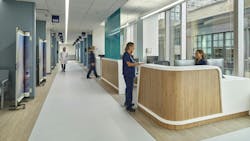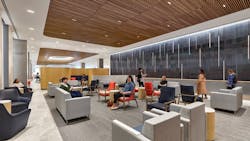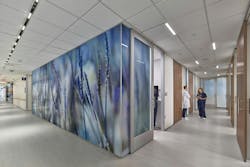Stantec Catalyzes Jefferson Health’s Care Delivery in Philadelphia
Jefferson Health recently opened the Honickman Center, now home to over a dozen specialty practices previously scattered throughout 10 buildings. Global integrated design firm, Stantec, served as the architect of record for fit-out of the building. The firm partnered with Ennead Architects, the core and shell architect, to help plan the facility for its intended ambulatory care use.
Located in the heart of Center City Philadelphia, the $762 million, 462,000-square-foot facility serves as a catalyst for changing the health system’s delivery of care. Virtual and technology strategies augment physical space planning, engaging patients and offering convenience during the pre-arrival stage of care. Valet and concierge services support a seamless arrival experience.
Patient-centered Experience
Reimagining care with the support of new technologies allowed the Stantec team to eliminate spaces and streamline processes. Traditional steps along a patient’s journey were eliminated by bringing services to the patient at their point of care. The intake process, which typically requires stopping at an alcove to collect height and weight information, now occurs in the private exam room. Information is automatically transmitted to the patient’s electronic medical record, using smart exam tables.
“By collaborating closely with the care team at Jefferson Health, we were able to create process improvements that enhance the patient experience, staff workflow, and spatial implications,” said Kristy Hollis, principal for Stantec. “We are proud to help create a place where our Philadelphia community can receive the best comprehensive care that supports their health and well-being.”
Amenity Support Throughout the Tower
The Honickman Center includes over 300 exam rooms, 58 infusion chairs, eight operating rooms, five endoscopy rooms, imaging, lab services and a pharmacy. The tower also features two levels of amenity space available to patients, visitors and the public. Amenities include a large café, community event space and a large-scale lounge area. As patients move up to the clinical floors, public spaces are smaller and support a quiet and calm experience. The offering of amenities continues with programs like image recovery and lounge space for cancer patients and access to a rooftop terrace on the 15th floor.Modular Prefab Exam Rooms
While convenient for patients, this vertical campus proved challenging from a construction logistics standpoint. With only inches between the building perimeter and property line, all construction activity had to occur within the footprint of the building itself. Standardizing the building layout and prototyping exams spaces allowed for more than 300 exam rooms across 10 stories, fully constructed out of prefabricated demountable partitions and a standard kit of parts. This just-in-time strategy resulted in the floors being turned over to Jefferson months quicker than traditional stick-built methods.
Neurodiverse Inclusive Design
An estimated 15-20% of the global population is neurodivergent, and design focused on reducing stress in patients must consider the neurodivergent as well as the neurotypical. With the leadership of the Jefferson Center for Autism and Neurodiversity, as well as input from neurodivergent focus groups, Stantec’s designers created a destination that supports a positive care experience for all.
Upon arrival, patients can obtain sensory support kits. Neutral yet warm finishes, free of bold patterns, set a calming and welcoming tone. Waiting spaces provide large- and small-scale seating that integrate tactile elements, soothing motions or reduction in ambient noise. These areas also include feature walls and dynamic art installations meant to reduce anxiety and provide positive distraction. Glazing is utilized at many of the transitions between environments, allowing patients to anticipate and prepare for what is next in their journey.
Learn more about health design at Stantec.



